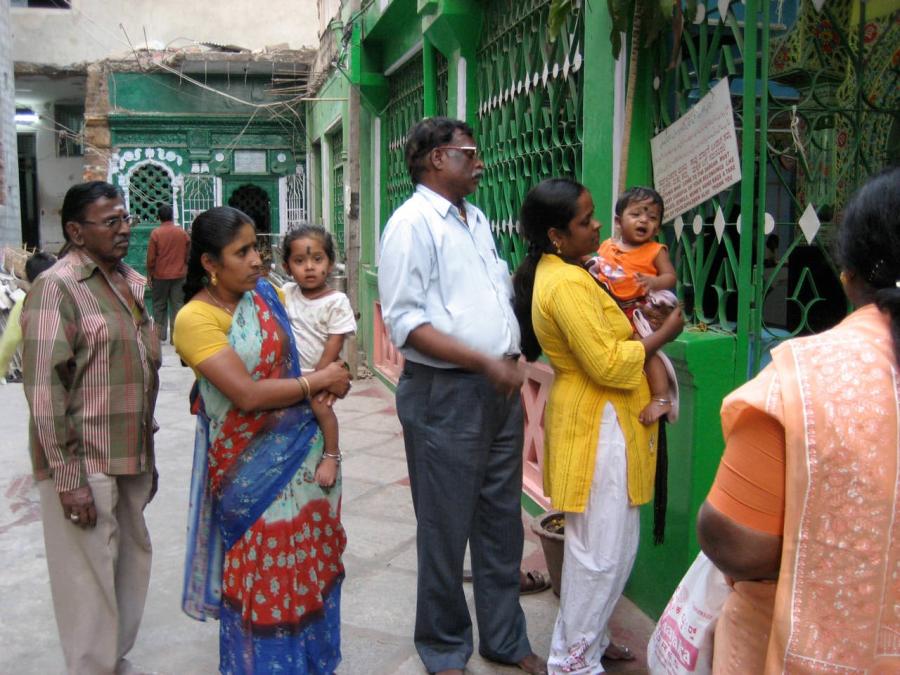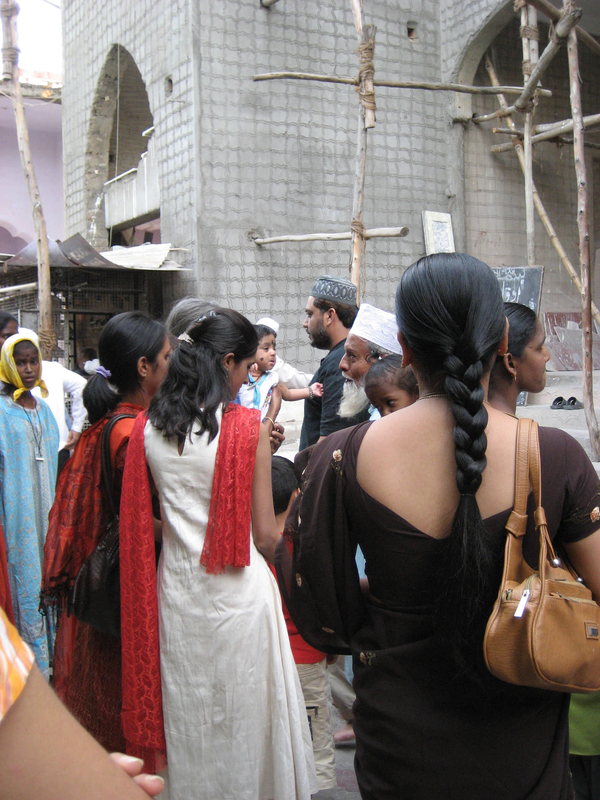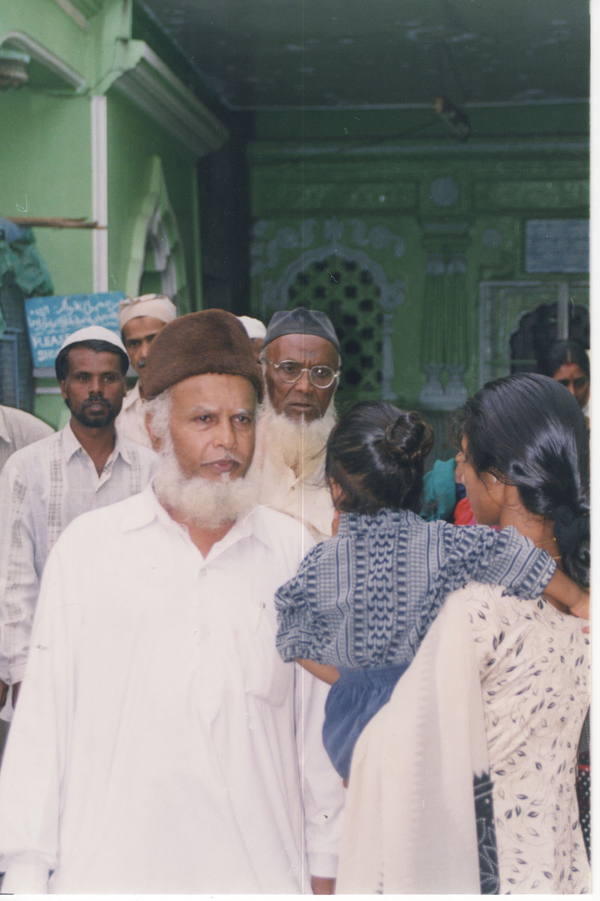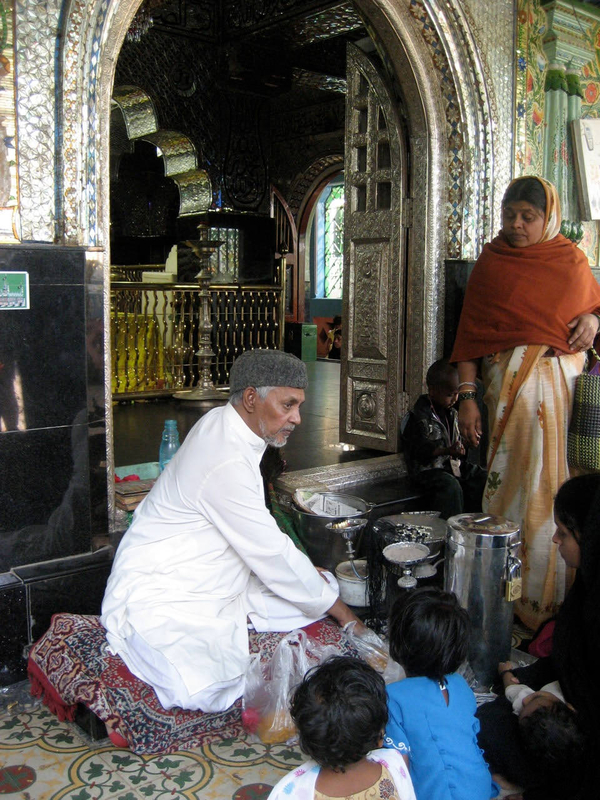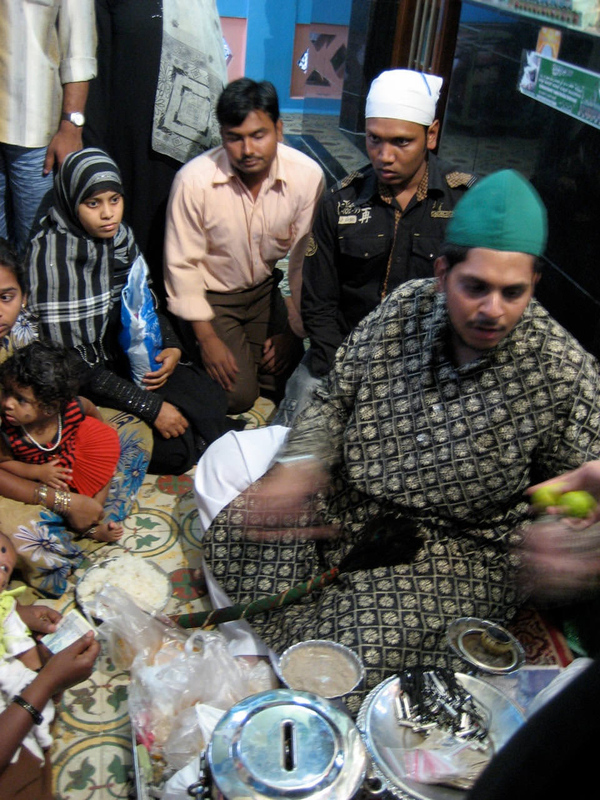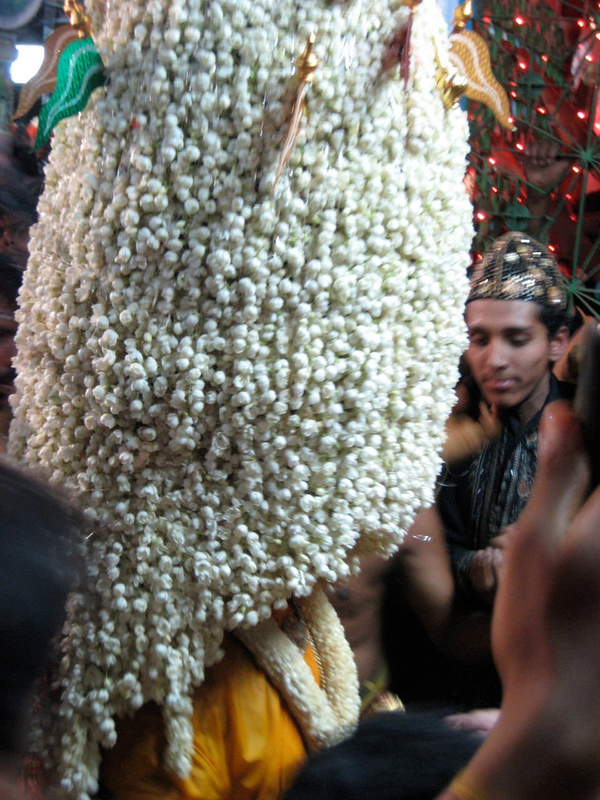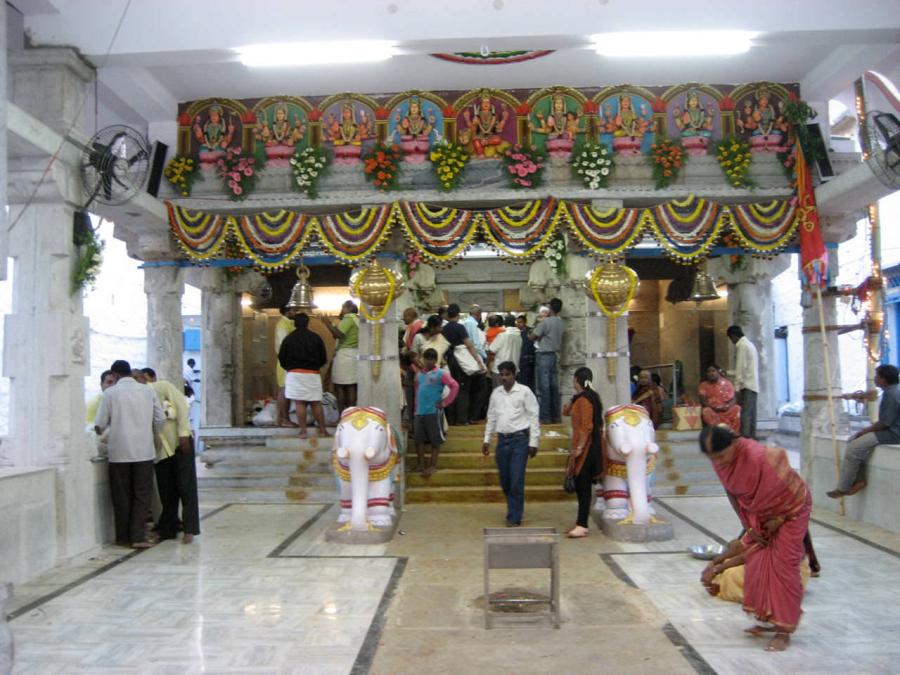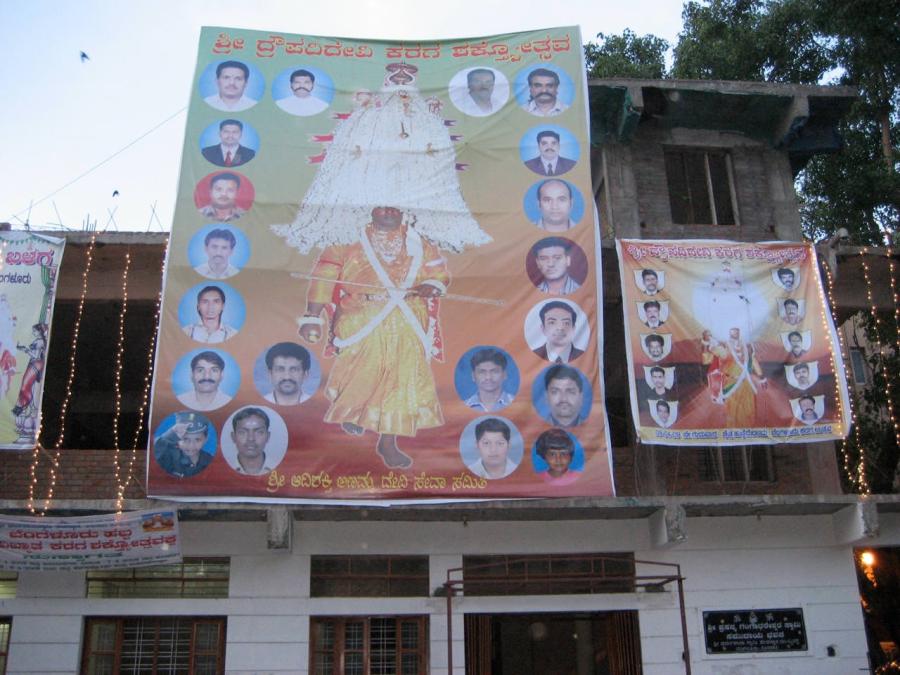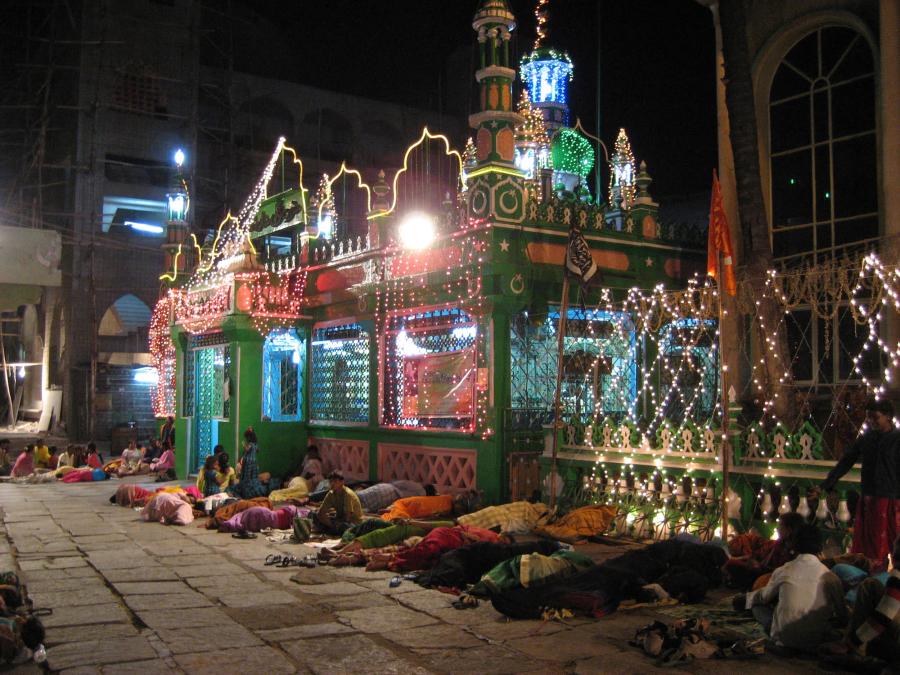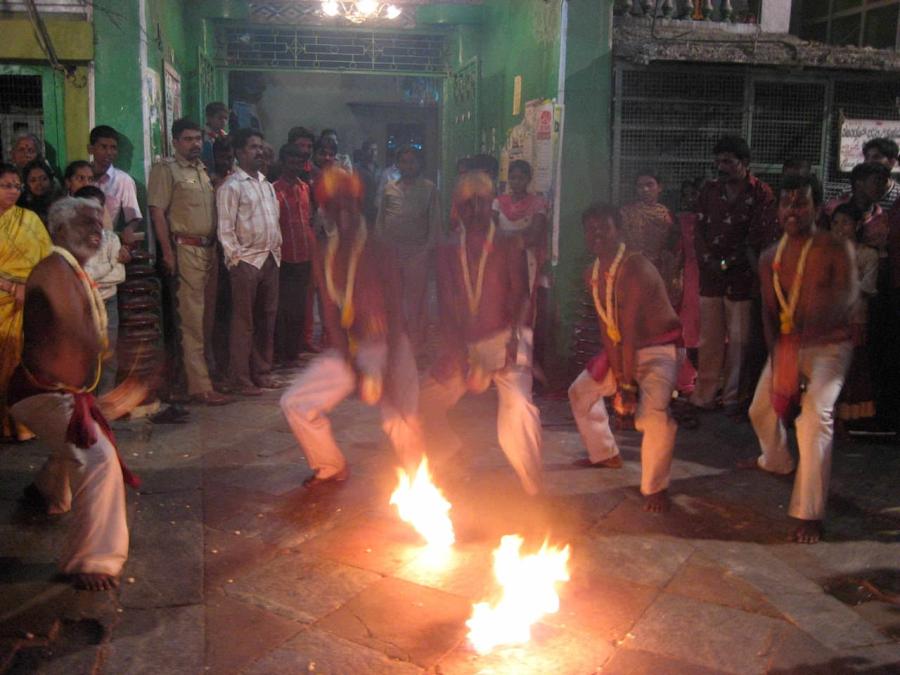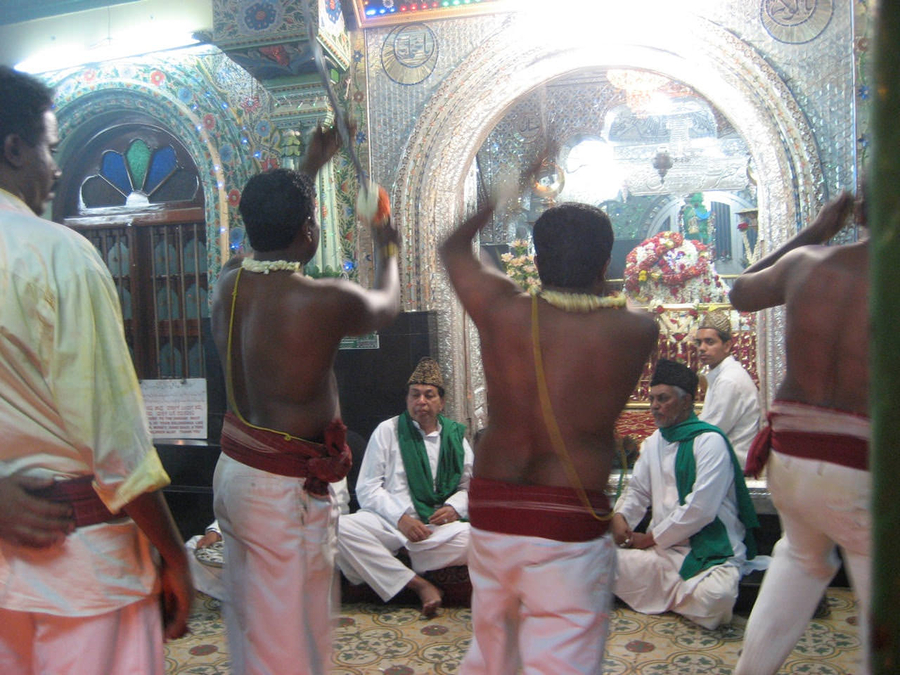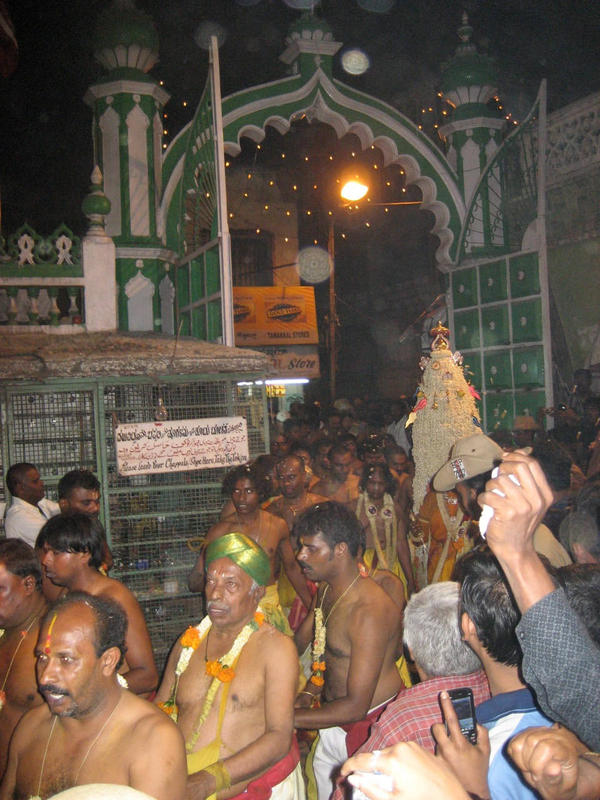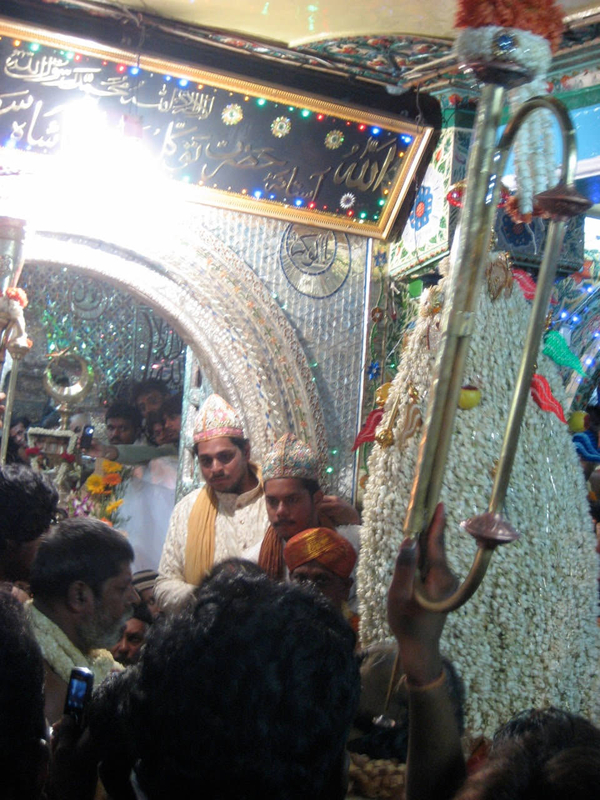Anna Bigelow is Associate Professor of Islamic Studies in the Department of Religious Studies and Director of the Center for South Asia at Stanford University. She is editor and contributor to Islam through Objects (Bloomsbury 2021) and the author of Sharing the Sacred: Practising Pluralism in Muslim North India (Oxford 2010).
The question of Muslim belonging is hardly new to India, nor unique to it. But it arises with greater urgency in the current political moment in this country whose 170 million Muslims make up just fourteen percent of the population.1 This is a time in India when high-ranking elected officials openly call for acts of violence against Muslims, accusing them of being the source of social division, unrest, and bloodshed in India and beyond.2 It is a time when Hindu nationalist leaders and activists routinely call for loyalty tests for Muslim Indians and physically assault them or tell them to move to Pakistan if, for example, they refuse to repeat slogans invoking India as a goddess—“Bhārat Mātā ki jai.”3 It is a time when some Muslims make public displays of writing this slogan in their own blood to demonstrate fealty to the state.4 It is a time when the history of Muslims in India is being systematically erased from school curricula and their contributions to the culture ignored or denied.5 It is a time when exaggerated fears of Muslim demographic growth fuel attacks by both official patrols and vigilante groups on Muslim men, accusing them of a so-called “love jihad” intended to seduce women of other religions.6 It is a time of occasional, highly publicized ceremonies of ghar wapsi (homecoming) when communities that may have been Muslim or Christian for generations are targeted for “reversion” to Hinduism as the native religion of all ethnic South Asians.7 It is a time when an accusation of possessing or transporting beef can result in death.8 It is a precarious time for all minorities in India, including Muslims, who are the frequent targets of erasures, exaggerations, and executions in mundane and everyday ways as well as in grand spectacles of unbelonging.
Although many Indians (both Muslim and non-Muslim) vigorously argue that Muslims are not aliens and engage in public performances that affirm Muslim belonging, at the moment advocates for Muslim unbelonging are politically ascendant. The current ruling Bharatiya Janata Party (BJP) and its constellated allies known as the Sangh Parivar are religious nationalists and came to power with an outright majority in 2014—no easy feat in a multiparty parliamentary democracy—and reaffirmed their preeminence in 2019. Their core ideology of Hindu nationalism is known as hindutva (Hindu-ness) and equates being an Indian citizen with being Hindu. As put by V. D. Savarkar, the chief ideologue of hindutva, “These are the essentials of Hindutva—a common nation (raṣṭra), a common race (jati), and a common culture (sanskriti). All these essentials could best be summed up by stating in brief that he is a Hindu to whom [India] is not only a pitrabhumi [fatherland] but also a punyabhumi [holy land].”9 In this sense, hindutva denotes a cultural and territorial identity that excludes from national belonging those whose holy lands are outside the borders of India. Since Islam and Christianity are not only associated with former imperial powers but also have roots and holy places in the Middle East, Muslims and Christians are portrayed in these discourses as suspect and alien. A common refrain among hindutva activists is heard here from Sadhvi Kamal Didi, a cow protection movement leader, in May 2017: “Whoever wants to stay here in India, they stay here as a Hindu. This is our country, we should dominate, and things should happen according to us.”10Anil Kote, a Bajrang Dal (Brigade of Hanuman—a Hindu nationalist militant organization) leader in Chikmaglur, Karnataka, asserted in a 2009 interview, “Now with Muslims, you’ve seen from the beginning how they’ve been ruining our nation. If we now give this up to them, they’ll ask for something else next. And again and again. If we thwart them at this, they will not attempt to interfere in anything again. . . . We Hindus are in the majority. If they listen to us, nothing will happen to them.”11 Or as Mohan Bhagwat, the head of the Sangh Parivar’s main organization, the RSS (Rashtriya Swayamsevak Sangh), put it in a 2014 newspaper interview, “Hindutva is the identity of India and it has the capacity to swallow other identities. We just need to restore those capacities.”12 Since Bhagwat uttered these words in 2014, the capacity of hindutva to “swallow other identities” has sharply increased, reducing the social and physical space for minorities of all sorts. Bhagwat himself participated in placing the foundation stone at Ayodhya for the building of a Hindu temple on the site of a destroyed sixteenth-century mosque, the Babri Masjid—a triumph he shared with Prime Minister Narendra Modi.13 Those who dare to challenge the direction of the country now risk prosecution for sedition, intimidation, and death.14 The precarity of Muslim belonging became even more evident with the introduction of the Citizenship Amendment Act (CAA) in 2019, which allows for expedited citizenship claims for Hindus, Sikhs, Jains, Buddhists, and Christians from neighboring countries, but not Muslims. The introduction of the CAA was accompanied by accelerated enforcement of the National Registration of Citizens (NRC), a law that requires documentation of ancestral belonging in territorial India to establish citizenship. The ongoing concern is that while many Indians are likely unable to provide such materials, only Muslims would be unable to claim the right to restore their Indian citizenship through the CAA.15
Through threats and actual violence, Muslims and Christians are divided from the Hindu majority community. This is also achieved by flattening the caste and philosophical diversity as well as the complex histories of Hinduism, by rhetorically absorbing Sikhs, Buddhists, and Jains into the Hindu fold, and by systematically framing Muslims as aliens, terrorists, unpatriotic, and destructive.16 Hindutva supporters see the Hindu majority as unfairly bearing the burden of state secularist policies such as reserved positions in education and government employment for minorities and ethnic groups historically excluded from such opportunities. From this perspective, Muslims and other minorities are seen as the beneficiaries of reserved positions in public institutions and of other preferential treatment—but as not contributing substantively to the collective good, or even as being part of the collective itself. Erasing Indo-Muslim history from the subcontinent through the destruction of Muslim sites, the rewriting of textbooks, and the introduction of laws such as the CAA makes it explicit that Muslims are not recognized as Indians by the current regime and many of its supporters. This lack of recognition of citizenship may extend to a refusal to recognize Muslim humanity, making arenas of Muslim interaction with non-Muslims even more critical spaces for the actualization of other possible futures. As Veena Das points out, community at all levels is “constituted through agreements and hence can also be torn apart by the refusal to acknowledge some part of the community (e.g. women or minorities) as an integral part of it.”17 Refusal to acknowledge the existence of the other is what philosopher Stanley Cavell called “a skeptical process toward other human beings” resulting “not in a realization of my ignorance of the existence of the other, but in my denial of that existence, my refusal to acknowledge it, my psychic annihilation of the other.”18 Engaging Cavell, Das argues that this psychic annihilation connects events of actual violence to the mundanity of daily life, since the spectacular is “always attached to the ordinary as if there were tentacles that reach out from the everyday and anchor the event to it in some specific ways.”19 The acts of everyday erasure that are proceeding apace in India today—the changing of road signs to remove Islamic place names, the paving over of demolished Muslim holy sites, the court cases brought to wrest control of shared sacred sites—are connected to the cataclysm of Partition in 1947, riots following the Babri Masjid demolition in Ayodhya in 1992, pogroms in Gujarat in 2002, and daily acts of violence that remind Muslim Indians of their precarity. The upheavals of these calamitous events are spectrally present in the everyday experiences of all Indians, especially the most vulnerable. But they are not the whole story of Islam and Muslims in India.
In exploring the multiple modalities of Muslim belonging and unbelonging in India, the arenas in which Muslims and non-Muslims interact, especially at shared holy places, are extremely illuminating locales. In earlier work on a Muslim principality in Indian Punjab where most Muslims stayed at the time of Partition and where the absence of violence then helped (among other factors) to anchor a collective identity based on interreligious harmony, it emerged that one key site for the performance of that identity is the tomb shrine of the Sufi saint who founded the town, as it is visited regularly by Muslims, Hindus, and Sikhs.20 Other research on shared sites reveals the ways in which ritual performance, ownership, and site identity become vectors through which collective belonging or unbelonging are drawn.21 Whether peacefully shared or contested, monumental or wayside, shared shrines expose the mundane ways in which these popular and ubiquitous shrines are public spaces of reimagining the extent and the limits of multireligious belonging in India. As such they are places that make apparent what Anand Vivek Taneja calls “the political theology of everyday life.”22 In these spaces of potent imaginaries that are both inside and outside of daily life, the markers and vectors of belonging, unbelonging, and possibility are materialized through embodied practices and physical objects.23 This essay explores the ways in which material and somatic forms of interreligious encounter at a Sufi dargah, or tomb shrine, in Bengalaru (Bangalore) exemplify everyday as well as spectacular practices of shared piety that also reimagine the possibility of collective belonging in a time of precarity.24
- 1The author thanks Emily Floyd, Kambiz GhaneaBassiri, and Mudit Trivedi as well as the anonymous reviewers for their helpful feedback and insights. Also, much gratitude to Rachana Rao Umashankar who collaborated in some of the research and translation from Kannada.
- 2Alishan Jafri, “As BJP Readies Anti-‘Love Jihad’ Laws, Hindu Activists Ramp Up Violent Rhetoric,” The Wire, November 17, 2020, https://thewire.in/communalism/anti-love-jihad-protests.
- 3“Muslim Man Slapped for Not Saying Bharat Mata Ki Jai, Video Goes Viral,” Aaj Tak, YouTube, July 12, 2017, https://www.youtube.com/watch?v=U3diW39hra0.
- 4“‘Bharat Mata Ki Jai’ Slogan Attracts Fatwa from Islamic Seminary,” The Quint, March 22, 2016, https://www.thequint.com/news/hot-news/bharat-mata-ki-jai-slogan-attracts-fatwa-from-islamic-seminary.
- 5Tanika Sarkar, “How the Sangh Parivar Writes and Teaches History,” in Majoritarian State: How Hindu Nationalism is Changing India, ed. Angana P. Chatterji, Thomas Blom Hansen, and Christophe Jaffrelot (NY: Oxford University Press, 2019); Lars Tore Flaten, Hindu Nationalism, History, and Identity in India: Narrating a Hindu Past under the BJP(London: Routledge, 2017); Romila Thapar, “The History Debate and School Textbooks in India: A Personal Memoir,” History Workshop Journal 67 (2009), 87-98.
- 6Julie McCarthy, “Vigilantes in India: Protecting Sacred Cows, Promoting a Hindu Way of Life,” NPR, May 2, 2017, http://www.npr.org/sections/parallels/2017/05/02/526426203/vigilantes-in-india-protecting-sacred-cows-promoting-a-hindu-way-of-life. Note the quote from Nagendra Tomar: “‘In Muslim-dominated areas of India Hindu girls are lured into having sexual relations’ with Muslim men, ‘and then they convert them.’”
- 7B. V. Shiva Shankar, “Karnataka: Mahasabha set to launch ‘ghar wapsi’ drive,” Times of India, November 22, 2021, https://timesofindia.indiatimes.com/city/bengaluru/karnataka-mahasabha-set-to-launch-ghar-wapsi-drive/articleshow/87840800.cms. Though typically enacted as spectacles of ‘reconversion’ of Christians or Muslims, there is also the suggestion that a more literal ‘homecoming’ for Muslim Indians would mean their migration to Pakistan. See Hamza Khan, “Actual ghar wapsi will be sending Muslims to Pakistan: Shiv Sena,” The Indian Express, December 16, 2014, https://indianexpress.com/article/cities/lucknow/actual-ghar-wapsi-will-be-sending-muslims-to-pakistan-shiv-sena/.
- 8Human Rights Watch, “India: Vigilante ‘Cow Protection’ Groups Attack Minorities,” Human Rights Watch, February 18, 2019, https://www.hrw.org/news/2019/02/19/india-vigilante-cow-protection-groups-attack-minorities#.
- 9V. D. Savarkar, Hindutva, or Who is a Hindu? (1923; repr., Bombay: Veer Savarkar Prakashan, 1969), 116. N. B. Savarkar used the term “Sindhusthan” to designate what is more commonly called Hindustan, geographically the same, i.e. the land east and south of the Indus River. For more on Savarkar and his ideas about violence, see Vinayak Chaturvedi, “Violence as Civility: V.D. Savarkar and the Mahatma’s Assassination,” South Asian History and Culture 11, no. 3 (2020): 239-253.
- 10Julie McCarthy, “Vigilantes in India Protecting Sacred Cows, Promoting a Hindu Way of Life,” Morning Edition (National Public Radio, May 2, 2017). http://www.npr.org/sections/parallels/2017/05/02/526426203/vigilantes-in-india-protecting-sacred-cows-promoting-a-hindu-way-of-life (accessed May 3, 2017).
- 11Anil Kote, interview with author, March 23, 2009. Kannada to English translation by Rachana Rao Umashankar.
- 12Omar Rashid, “Hindutva Is India’s Identity, Says Bhagwat,” The Hindu, August 18, 2014, https://www.thehindu.com/news/cities/mumbai/hindutva-is-indias-identity-says-bhagwat/article6326416.ece.
- 13Sharat Pradhan, “At Ayodhya Bhoomi Pujan, Modi Became All-in-One; Proper Rituals Not Followed, Allege Pundits,” The Wire, August 7, 2020, https://thewire.in/politics/ayodhya-bhoomi-pujan-narendra-modi-priests-pundits.
- 14Siddhartha Deb, “The Killing of Gauri Lankesh,” Columbia Journalism Review, Winter 2018, https://www.cjr.org/special_report/gauri-lankesh-killing.php; PTI, “Anti-CAA Drama: Sedition Case against Karnataka School Management Challenged in SC,” The New Indian Express, February 21, 2020, https://www.newindianexpress.com/states/karnataka/2020/feb/21/anti-caa-drama-sedition-case-against-karnataka-school-management-challenged-in-sc-2106610.html; Anumeha Yadav, “How India Uses Colonial-Era Sedition Law against CAA Protestors,” Al Jazeera, January 20, 2020, https://www.aljazeera.com/news/2020/01/india-colonial-era-sedition-law-caa-protesters-200120100338578.html.
- 15The National Registration of Citizens (NRC) is a program established by a 2003 amendment to the 1955 Citizenship Act establishing who is a citizen of India. The program to implement the NRC began in Assam in 2013 and has resulted in thousands of detentions and lists of millions of potential non-citizens. See Nazimuddin Siddique, “Inside Assam’s Detention Camps: How the Current Citizenship Crisis Disenfranchises Indians,” Economic and Political Weekly 55, no. 7 (February 15, 2020), https://www.epw.in/engage/article/inside-assams-detention-camps-how-current.
- 16Badri Narayan, Fascinating Hindutva: Saffron Politics and Dalit Mobilisation (Los Angeles: SAGE, 2009); Christophe Jaffrelot, Religion, Caste, and Politics in India (London; Hurst & Co, 2011); Nandini Sundar, “Hindutva Incorporation and Socioeconomic Exclusion: The Adivasi Dilemma,” in Majoritarian State: How Hindu Nationalism is Changing India, ed. Angana P. Chatterji, Thomas Blom Hansen, and Christophe Jaffrelot (Oxford University Press, 2019) 249-257.
- 17Veena Das, Life and Words: Violence and the Descent into the Ordinary (Berkeley: University of California Press, 2007), 9.
- 18Stanley Cavell, quoted in Das, Life and Words, xiii.
- 19Das, Life and Words, 7.
- 20Anna Bigelow, Sharing the Sacred: Practicing Pluralism in Muslim North India (NY: Oxford University Press, 2010).
- 21Rachana Rao Umashankar, “Metropolitan Microcosms: The Dynamic Spaces of Contemporary Sufi Shrines in India,” South Asian Studies 31, no. 1 (2015): 127-143; Peter Gottschalk, Beyond Hindu and Muslim (Delhi: Oxford University Press, 2000); Richard H. Davis, “The Rise and Fall of a Sacred Place: Ayodhya over Three Decades,” in Culture and Belonging in Divided Societies: Contestation and Symbolic Landscapes, ed. Marc Howard Ross (Philadelphia: University of Pennsylvania Press, 2009); Carla Bellamy, Powerful Ephemeral: Everyday Healing in an Ambiguously Islamic Place (Berkeley, CA: University of California Press, 2011); Ron E. Hassner, War on Sacred Grounds (Ithaca: Cornell University Press, 2009); Robert Hayden, Antagonistic Tolerance: Competitive Sharing of Religious Sites and Spaces (Abingdon: Routledge Press, 2016).
- 22Anand Vivek Taneja, Jinnealogy: Time, Islam, and Ecological Thought in the Ruins of Delhi (Stanford, CA: Stanford University Press, 2018), 46-50.
- 23See for example Joyce Flueckiger, In Amma’s Healing Room: Gender and Vernacular Islam in South India(Bloomington, IN: Indiana University Press, 2006).
- 24The notion of shared piety is productively explored by Farina Mir in The Social Space of Language: Vernacular Culture in British Colonial Punjab (Berkeley: University of California Press, 2010).
Sufi Shrines as Circulatory Systems
Very few people come and go from Sufi tomb shrines without bringing something, contacting something while there, taking something away, or some combination of the above. Of course, Marcel Mauss and his followers and critics theorized long ago about the symbolic transaction of power at root in the gift exchange.1 Gregory Starrett, Laurel Kendall, Christiane Gruber, and others have explored religious commodities and the power of the bought and sold, elucidating how selective consumption is a form of spiritual and social entrainment, both for the individual and for a wider public.2 These circulatory models of the exchange of objects and production of piety provide analytic tools for shrine-based devotions that interweave commercial transactions with the unique interactional (and often interreligious) etiquette appropriate to each site. Also helpful is Nile Green’s study of the religious economy of Islam in colonial India, Bombay Islam, where he proposed a market analogy to understand the networks of exchange that circulated not only currencies and commodities, but spiritual concepts and rival religiosities.3 Such metaphors are useful to explain certain aspects of religious life, identifying systems of value that compete for consumers, and help to reveal the spiritual, political, and economic underpinnings of power. But shrine cultures go beyond the transactional and commodified, involving wider sensory repertoires that generate the productive, consumptive, aesthetic, and performative aspects of interactional spaces. To be sure, Sufi shrines in India are embedded in local economies, politics, and authority structures. But these places also gather people for reasons that exceed the instrumental and the transactional. Bengalaru-based journalist Siddiq al Duri explained it to me by saying that dargahs are helpful as they bring love between different languages and communities, and, as we cannot lead lives apart from others, we must work to create this atmosphere of positive engagement.4 To grasp the many possibilities facilitated within these spaces requires attention not just to the theologies, demographics, and social networks emplaced in these sites, but also to the ethical possibilities engendered by the relational exchanges of the stuff that is observed, heard, smelled, tasted, felt, offered, and taken at the shrine.
The material and somatic environment of a sacred site is as important as the theological concepts that intersect there. Emplaced objects, and the people who engage them, facilitate or inhibit transactions between pilgrims and their conceptions of the divine—and between the many denizens of the shrine. Attention to the material culture and embodied practices that emerge at a sacred space constituted by people from multiple religious traditions allows the “felt life of belief” to emerge from the debates over doctrine that often overshadow the pragmatics, and the popularity, of multireligious sites.5 Extending religious studies beyond textual and discursive traditions allows the broader repertoire of meaning-making practices to enter the field.6 A similar effort has benefited the study of collective identity, nationalism, and the state. The discursive emphasis in the works of Benedict Anderson and Talal Asad is now usefully augmented by studies of the practice and pragmatics of citizenship in modern nation-states.7 Saba Mahmood, Hussein Agrama, and Noah Salomon, among others, look to everyday expressions of state power and the ways in which phenomena such as political secularism or religious nationalism are perhaps best observed through a “state effect.” The state effect is Timothy Mitchell’s observation that rather than being experienced directly, “the phenomenon we name ‘the state’ arises from techniques that enable mundane material practices to take on the appearance of an abstract, nonmaterial form.”8 In India, competing ideas about the abstraction of state secularism are expressed and interpreted through many mundane material practices. Or in another register, Anand Vivek Taneja observes in his study of the human and jinn denizens of Firoz Shah Kotla that the modes of interacting with the protective and mnemonic powers of the jinn are “a poetics of bearing witness to the postcolonial condition of everyday life in Delhi” providing “ironic commentary, counter-memory, and apotropaic magic.”9 For Tulasi Srinivas, in her work on wonder and “experimental Hinduism” in Bengalaru, as “these practices help to shape changeable views of power, practice, pluralism, and the problem of how to live with otherness, they sediment into an ongoing interrogation of ethical life.”10 The everydayness and habitual quality of Sufi shrines in India make them ideal venues to observe the state effects of rapidly shifting practices of secularism. How a shared site is regulated and imagined, promoted as a social good or challenged as illegitimate, and represented in political discourses is revealing of the state’s relationship to religion—and especially to religious minorities.11 Observing these policies and imaginaries enables closer observation of the ways in which embodied, material practices relate to the meaning systems in which they are located. At Sufi tombs in India, the expansive, interactive sensorium of shrine culture provides insight into how visitors situate themselves within the ambivalently secular state of India, and thereby also illuminates the pragmatics of coexistence in plural communities more generally.
- 1Marcel Mauss’s The Gift (Essai sur le don) (Chicago: Hau Books, 2016 [1923-4]) is the first of many works to consider the social power of gifts and the systems and logics that giving and receiving entail. An interesting critical engagement from South Asian studies is Jonathan Parry’s “The Gift, the Indian Gift, and the ‘Indian Gift,’” Man 21, no. 3 (1986): 453-73. Parry points out the limits of Mauss’s universal claims and the importance of culturally specific typologies of gifting.
- 2Gregory Starrett, “The Political Economy of Religious Commodities in Cairo,” American Anthropologist 97, no. 1 (1995): 51-68; Laurel Kendall, “Can Commodities be Sacred? Material Religion in Seoul and Hanoi” in The Handbook of Religion and the Asian City: Aspiration and Urbanization in the Twenty-First Century, ed. Peter van der Veer (Berkeley: University of California Press, 2015); Christiane Gruber, “Prophetic Products: Muhammad in Contemporary Iranian Visual Culture,” Material Religion 12, no. 3 (2016): 259-293.
- 3Nile Green, Bombay Islam: The Religious Economy of the West Indian Ocean, 1840-1915 (Cambridge: Cambridge University Press, 2011).
- 4Siddiq al Duri, interview with author, March 25, 2009.
- 5David Morgan, “Materiality, Social Analysis, and the Study of Religions,” in Religion and Material Culture: The Matter of Belief, ed. David Morgan (London: Routledge, 2010), 56.
- 6An important point in this regard comes from Sam Gill, Dance Culture Religion (Lanham, Muhammad: Lexington Books, 2012), in which he suggests that bodily movements—especially dance—are more universal modes of meaning making than text or certainly scripture, yet are far less studied or considered essential to understanding “religion”.
- 7Benedict Anderson, Imagined Communities: Reflections on the Origins and Spread of Nationalism (London: Verso, 2006 [1983]); Talal Asad, Formations of the Secular: Christianity, Islam, Modernity (Stanford: Stanford University Press, 2003).
- 8Timothy Mitchell, “Society, Economy, and the State Effect,” in State/Culture: State Formation after the Cultural Turn, ed. George Steinmetz (Ithaca, NY: Cornell University Press, 1999), 77. See also, Saba Mahmood, Politics of Piety: The Islamic Revival and the Feminist Subject (Princeton: Princeton University Press, 2005) and Religious Difference in a Secular Age: A Minority Report (Princeton: Princeton University Press, 2016); Hussein Agrama, Questioning Secularism: Islam, Sovereignty, and the Rule of Law in Egypt (Chicago: Chicago University Press, 2012); Noah Salomon, For Love of the Prophet: An Ethnography of Sudan’s Islamic State (Princeton: Princeton University Press, 2016).
- 9Taneja, Jinnealogy, 25.
- 10Tulasi Srinivas, The Cow in the Elevator: An Anthropology of Wonder (Durham, NC: Duke University Press, 2018), 16.
- 11This is part of the argument I make in the essay “Lived Secularism: Studies in India and Turkey,” Journal of the American Academy of Religion 87, no. 3 (2019): 725-764.
Hazrat Tawakkal Mastan Shah حضرت توکل مستان شاہ (d. 1777)
The dargah dedicated to the Sufi saint Hazrat Tawakkal Mastan Shah is in the heart of Bengalaru’s old city. The saint is linked to the rebuilding of the historic Kalasipalya Fort by the eighteenth-century rulers Haider Ali (r. 1761-1782) and his son Tipu Sultan (r. 1782-1799). One popular story is that Sufi adepts Tawakkal Mastan and his two brothers Tipu and Manak were working as masons on the fort when it came to the attention of their supervisors, and eventually Haider Ali himself, that they were not accepting wages for their labor. Instead, they asked for (or in other accounts Haider Ali simply built in their honor) a mosque in the neighborhood called Cottonpet. Tawakkal Mastan’s tomb is popular with local Muslims as well as the Hindu and Christian communities. As at other dargahs throughout South Asia, visitors of all religions come with prayers for healing, employment, health, marriage, children, and more. This essay analyzes three types of transactions that occur at this site, each of which involves the voluntary participation of religious others. First is a healing, effected by blowing purified breath over the afflicted—duʿā’ phunkna. The second is the traffic in amulets by the shrine's caretakers that purport to help myriad problems. The third and most spectacular exchange is not only between the pilgrims, caretakers, and the saint, but also between the saint and his annual visitor—the Hindu divinity Draupadi as embodied by a Hindu priest. About two kilometers away from the dargah is the Sri Dharmaraya Swamy temple dedicated to this heroine of the epic Mahabharata. Once a year, a priest from the temple becomes the goddess’s vehicle and takes on the enormous responsibility of not only manifesting her divinity but also carrying an enormous pot called a karaga—filled with objects known only to the priests who conduct the ritual—covered with a huge mound of jasmine flowers on a nine-plus hour dancing circumambulation of the old city in what Smriti Srinivas calls “the primary civic ritual in Bangalore.”1 One of the karaga’s way stations is the dargah of Hazrat Tawakkal Mastan Shah, a meeting that is commonly interpreted by participants, attendees, and the media as emblematic of the positive, multicultural form of Indian secularism and affirming of Muslim belonging.
- 1Smriti Srinivas, Landscapes of Urban Memory: The Sacred and the Civic in India’s High-Tech City (Minneapolis: University of Minnesota Press, 2001), 20. Srinivas’s book is the most comprehensive study to date of Bengalaru and the karaga.
Breathing the Other
Of the three examples of embodied practice centered at Hazrat Tawakkal Mastan’s dargah, the first is the most quotidian. This is an engagement of breath, an encounter between Muslim men and a largely non-Muslim clientele requiring the mutual recognition of those in need of help and those believed to be (and believing themselves to be) in a position to help. Next to the tomb is a mosque. After each of the five daily namaz prayers, but mostly in the afternoons and evenings, Hindu families line up with their children outside the mosque. The men leaving after prayer (namazis) are confronted as they exit by a line of people in need, standing between the mosque and the tomb, expecting them to blow their breath as a prayer (duʿā’ phunkna) over their children. These are not religious professionals, associated with the mosque or the tomb shrine, but average attendants at namaz who are recognized as sources of power by the other denizens of the spaces. Namaz involves recitation of formulaic prayers accompanied by bodily motions, repetition of passages from the Qur’an, and personal supplicatory prayers (duʿā)—all activated through proper intention (niyyat) and a conscious turn of focus towards God. As the medieval scholar Abū Hamīd al-Ghazāli (d. 1111) put it, “Action without a true intention is show and pretense; it is a cause for rejection, not closeness [to God].”1
- 1Abu Hamīd Al-Ghazāli, On Intention, Sincerity, and Truthfulness/ Kitāb al-niyya wa’l-ikhlāṣ wa’l-ṣidq (Book XXXVII of the Revival of the Religious Sciences), trans. Anthony F. Shaker (Cambridge, U.K.: The Islamic Texts Society, 2013), 40.
Some namazis blow softly on the children, sometimes touching them and praying silently or quietly, sometimes simply blowing and moving on. It is a simple act, and one that not every namazi does, but many do take time to stop and offer this comfort to concerned parents. This is not uncommon at mosques in South Asia, where different congregations are known for helping with various problems. The breath of the Tawakkal Mastan mosque namazis reputedly relieves nightmares and other common childhood disorders like diarrhea or bed-wetting. The participants (both the namazis and those who await them) report that the power of healing is in the breath made pure by their recent prayers. These encounters resonate with practices elsewhere in India, such as the Hyderabadi healer Amma with whom Joyce Flueckiger worked for years. Amma was frequently solicited for her healing breath by a religiously mixed clientele. After reciting verses from the Qur’an (also a necessary part of namaz), she would blow directly onto a supplicant or onto water or rice to be consumed as a blessing elsewhere.1 Though people may seek out those seen as particularly pious or understood to be religious professionals, such as Amma, to obtain their presumably powerful breath, laywomen and men also perform these blessings for one another in a myriad of contexts. A similar practice occurs in many Muslim households as well. The quotidian nature of the practice at the Tawakkal Mastan mosque between Muslim men and a religiously mixed group of supplicants suggests that these are communities habituated to and recognizing of one another, rather than skeptical of one another, which as Cavell suggested can lead to a “psychic annihilation” of the other.
- 1Joyce Burkhardt Flueckiger, “The Agency of the Material Taviz (Amulet) in a South Indian Healing Room,” in Islam through Objects, ed. Anna Bigelow (London: Bloomsbury, 2021), 130.
The mutual intelligibility of the breath exchange evokes logocentric practices found in Muslim and Hindu traditions. Speech-acts in both religions produce efficacious words that may have transformative, apotropaic, prophylactic, and didactic force. In Islamic traditions it is most common—and least controversial—to utter the words of the Qur’an over an object or substance (water, oil, rice, or grain) and to understand that utterance as imbuing the substance with the curative power of the Qur’an.1 Practitioners find validation in passages such as Qur’an 17:82, which states, “And we sent down in the Qur’an that which is a healing and a mercy to the believers.” In other cases, passages, numbers, or words written in various ways (with sandalwood pens, with saffron tinted water, or on boards or food) are rinsed clean or dissolved in a liquid that is then capable of conveying baraka—the transmittable power of spiritual blessing.2 At Hazrat Tawakkal Mastan, the recitation of prayers in the mosque by the namazis temporarily suffuses their breath with the sanctified healing power of the Qur’an itself, drawing on an ancient form of healing attested in various hadith as well as texts concerning tibb al-nabawi, or prophetic medicine.3 Yet this practice is not merely an expression of a widespread and widely-accepted tradition concerning the efficacious power of the Qur’an. Indeed, as a practice often occurring between Muslims and non-Muslims, it depends largely on a mutual recognition of need and efficacy to take place. It may matter little whether or not anyone involved is concerned with prophetic medicine in the Islamic tradition—nor how aware they are of similar transformative, curative, and benedictive practices that exist in Indic traditions, such as invocations and prayers whose effective energy relies as much, if not more, on the activation of cosmic sound as on comprehension.4 For example, pranayama, or breath practice, is a key aspect of Hindu yoga systems, supporting a spiritual physiology in which the quality of breath is variable and responsive to particular utterances, restraints and releases, and contemplative interventions.5 So breath purified and empowered by sacred words is part of the prevalent regional spiritual systems and operates by mutually recognizable, though not identical, mechanisms. Yet this practice goes a further step as the breath of Muslim men having recently uttered words of the Qur’an and other prayers is regarded as salutary and therefore sought by Hindus on behalf of their children. Clearly, for many Hindus and Muslims, the activating principle is neither the lexical meaning of the words nor the theological principles at play, rather it is the power of the intentional encounter between those in need and those able to offer comfort and help.6 This is all the more important as a daily practice in a society where Muslim men are stigmatized as predatory—whether towards cows or Hindu women—and more than occasionally suffer violently for such perceptions.7 Bengalaru has not been the most contentious region in Karnataka, but Hindu nationalist activism has gained ground in recent years.8 Nonetheless, Hindu parents regularly bring their children to Hazrat Tawakkal Mastan, even though in the vibrant spiritual milieux of the city there are numerous Hindu temples, large and small, many of which could offer similar relief. This wider context makes the act of asking a Muslim man to bless a non-Muslim child more than just utilitarian or expedient.
For the encounter to be efficacious, or even to occur, there must be acceptance of the performance by the participants, an ethical attunement that often takes place non-verbally. Essentially, both namazi and supplicant must agree both that this is an effective practice and that it is worth their while. Those namazis who pause to interact with the parents and children (and visiting scholars) explain this as a moral obligation, a manifestation of the kind of social attitudes resulting from a life in which daily prayer is a priority and an indication that the attributes of piety should not be confined to the mosque interior. From the petitioners’ perspectives, faith in the efficacy of such prayer is the crucial element—not the religion of those who offer the healing. In this place “all who come with a pure heart” will find welcome and relief, as one Hindu woman at the dargah put it.9 The practice may also have the intentional or unintentional effect of ingratiating the Muslim minority community to the Hindus who visit by offering what simple comforts they can to their neighbors from the majority. It normalizes a benign or even beneficial Muslim presence. Whether part of a political calculus or driven by deeply held spiritual convictions (or both), these exchanges are in their very everyday-ness central to the collective life of the shrine and require effort and persistence to maintain. As Charles Hirschkind argues, such sensory practices are also disciplinary practices that aid in honing “an ethically responsive sensorium.” It is important, therefore, to discover “how emotions, capacities of aesthetic appreciation, and states of moral attunement or being (i.e. sensibilities) come to structure fundamental sensory experiences.”10 In this regard, the degree of benefit is often understood to be proportional to the integrity of intention and the depth of mutual recognition in the moment of exchange. The transaction of breath with the namazis is one of many practices that activate the ethical and devotional culture of the shrine, providing an opportunity for social entrainment that shapes how all the encounters at the dargah complex are experienced and interpreted by the local community.
- 1Rudolph T. Ware, The Walking Qur’an: Islamic Education, Embodied Knowledge, and Healing in West Africa (Chapel Hill, NC: University of North Carolina Press, 2014); Katharina Wilkens, “Infusions and Fumigations: Literacy Ideologies and Therapeutic Aspects of the Qur’an,” in Sensing Sacred Texts, ed. James W. Watts (Sheffield, UK: Equinox, 2018).
- 2In the introduction (pp. 4-8) to his study Muhammad’s Body: Baraka Networks and the Prophetic Assemblage (Chapel Hill: University of North Carolina Press, 2020), Michael Muhammad Knight draws out the complex of meanings that emerge from the term baraka. In particular, he elucidates the material, somatic, and contagious aspects that are often flattened by the simple translation of “blessing.”
- 3bn Qayyim al Jawziyya, Medicine of the Prophet, trans. Penelope Johnstone (Cambridge: Islamic Texts Society, 1998).
- 4Fabrizio Speziale, Culture persane et médicine ayurvédique en Asie du Sud (Leiden: Brill, 2018); Carl W. Ernst, “A Fourteenth-Century Persian Account of Breath Control and Meditation,” in Yoga in Practice, ed. David Gordon White (Princeton: Princeton University Press, 2012), 133-140.
- 5Dominik Wujastyk, “The Science of Medicine,” in The Blackwell Companion to Hinduism, ed. Gavin Flood (Malden, MA: Blackwell, 2003); Dominik Wujastyk, “The Path to Liberation through Yogic Mindfulness in Early Ayurveda,” in White, Yoga in Practice; Guy Beck, Sonic Liturgy: Ritual and Music in Hindu Tradition (Columbia: University of South Carolina Press, 2012), 31-42.
- 6William Graham, Beyond the Written Word: Oral Aspects of Scripture in the History of Religion (Cambridge: Cambridge University Press, 1987)
- 7Arun Dev, “Muslim Man Traveling with Hindu Woman Stabbed in Karnataka: Cops,” The Hindustan Times, April 3, 2021, https://www.hindustantimes.com/india-news/muslim-man-travelling-with-hindu-woman-stabbed-cops-101617388864050.html; PTI, “Karnataka ‘Love Jihad’ Law Likely in Next Legislative Session: BJP,” The Week, February 17, 2021, https://www.theweek.in/news/india/2021/02/17/karnataka--love-jihad--law-likely-in-next-legislature-session--b.html.
- 8The most spectacular act of right-wing violence in Bengalaru in recent years was the killing of the journalist Gauri Lankesh on September 5, 2017. A leftist, activist, and critic of Modi’s BJP government, she was attacked and threatened long before her death. See Siddhartha Deb, “The Killing of Gauri Lankesh,” The Columbia Journalism Review, October 2018, https://www.cjr.org/special_report/gauri-lankesh-killing.php. For more on contemporary politics in Bengalaru and Karnataka, see Anna Bigelow, “Lived Secularism: Case Studies in India and Turkey,” The Journal of the American Academy of Religion 87, no. 3 (2019).
- 9Interview with author, March 25, 2009.
- 10Charles Hirschkind, “The Ethics of Listening: Cassette-Sermon Audition in Contemporary Egypt,” American Ethnologist 28, no. 3 (2001): 624.
Protective and Ameliorative Amulets (Ta'wiz تعویز)
Although also requiring cooperation and mutual recognition, unlike the breath practice, the making and taking of amulets is also in part a commercial transaction. Pilgrims typically give various, usually small, amounts of money in offering as they consult a caretaker (mujawwar) seated at the foot of the tomb. The mujawwars rotate in this position at this station throughout the day. People of all religions, genders, castes, and social classes wait in a queue to explain their concerns and be given a recommended course of action. Typically, a supplicant briefly outlines his or her reasons for requesting the saint’s help (a sick family member, a lost job, the hope for a child), then the mujawwar utters supplicatory prayers as he brushes peacock feathers over the head of the pilgrim. The peacock feather fan is used to sweep the tomb of the saint, and thus is infused with his baraka. For some the prayers and blessings are all that is desired or required, but others ask for additional, tangible items to transmit the saint’s healing and protective power, generally involving a monetary exchange. Considering money as a materialized form of power, the financial exchange is another level of efficacious interaction, intensifying the symbiosis of the dargah management and its constituency. As Christiane Gruber points out, “An amulet or talisman is largely conceived as a broker enabling human agents to negotiate and steer imperceptible yet energetic forces.”1 The most common form of amulet obtained at this tomb and others like it is a packet containing ash from the burning of flowers and incense offered at the tomb, used as an ilaj, or cure for an affliction. Having been offered with devotion and having existed for some period in contact with the effusive baraka that emanates from the entombed saint, the ash distills that effulgence into a readily transmissible substance. The ash may be dissolved in water and consumed, sprinkled over places in need of blessings, or worn around the arm or neck in small packets or capsules as protective blessings.2 As in many religious systems in South Asia, the purificatory and blessing power of objects often considered polluting in intra-human relations (ashes, left-over food, shoes, dust, or liquids used for cleansing) are profoundly beneficial when they result from contact with or proximity to a divine or spiritually exalted being. This both affirms a spiritual hierarchy and intensifies the ambivalent energy of contact with matter that would otherwise be avoided. In many Hindu traditions and in Ayurveda, vibhuti or bhasma (sacred ash made from ritual fires, cow dung, certain metals, or cremated human corpses) is used in a variety of ways—applied to the body in particular places or consumed.3 Ash produced in Hindu temples and rituals is also used to mark the body in particular points and designs, but this is not done with the residue from dargahs. Still, the idea that leftovers, such as the ash from offerings, should be beneficial or powerful for a devotee is likewise also resonant with the concept of prasad (divine remnants, specifically that which is distributed to the assembly after the divinity has accepted the essence of the offering).
- 1Christiane Gruber, “From Prayer to Protection: Amulets and Talismans in the Islamic World,” in Power and Protection: Islamic Art and the Supernatural, ed. Francesca Leoni (Oxford: Ashmolean Museum, 2016), 34.
- 2On amulets and healing in Islam, see Flueckiger, “Material Taviz (Amulet)”; Flueckiger, In Amma’s Healing Room;and Carla Bellamy, The Powerful Ephemeral: Everyday Healing in an Ambiguously Islamic Place (Berkeley: University of California Press, 2011).
- 3In their article “Bhasma: The Ancient Indian Nanomedicine,” Journal of Advanced Pharmaceutical Technology and Research 5, no. 1 (2014): 4-12, Dilipkumar Pal, Chandan Kumar Sahu, and Arindam Haldar argue that the incineration of particular substances (copper, gold, mica, iron, zinc, etc.) improves their absorption and assimilation and results in myriad health benefits (optimizing systemic alkalinity, bone density, kidney and liver cleansing, and improved sleep and mood).
Efficacious objects, in the form of lemons, ashes, images, strings, padlocks, grave cloths, and so forth are, in part, the production of the bodily disciplines that gave them meaning, and their exchange for money is accompanied by the acceptance of the spiritual currency that is given value by the collective as a purely voluntary experience. For the attendants at the dargah of Hazrat Tawakkal Mastan Shah and for the pilgrims, whether Hindu or Muslim, the exchange in terms of supplication, benediction, prescription, and remuneration unfolds in a fairly consistent transactional choreography, ensuring efficacy and the system’s continued functioning. It also completes the link between the supplicant and the saint through the mediation of the mujawwar. Indeed, this union is particularly apparent in practices of consumption and contact between pilgrims and the tomb and objects that have contacted the tomb. As Finbarr Barry Flood points out, this is part of the “redistributional economy” that circulates spiritual power from the saint through his grave to the objects that contact his grave, to those who obtain them. “In a manner comparable to the prasād offered to Hindu deities at their shrines, edible substances that absorb some of the sanctity of the deities who partake of them before they are redistributed for ingestion by the pious, such instances of ‘sensuous media’ enchain presence across space and time, linking the proven piety of the dead, or the sacred substance of deities, with the devotional aspirations of the living.”1 Flood further argues that contact and consumption allow for incorporation by the desiring devotee of some measure of the desired object of devotion:
Incorporating the charisma of the sanctified other into the very essence of the self, they amplify an underlying ambiguity between imitating and becoming that is perhaps central to all devotional practice. In doing so, they also highlight a capacity of materiality to mediate sacrality that operates both transculturally and transhistorically, however diverse the specific forms and meanings it assumes in particular times and places.2
Particularly interested in consumptive practices, Flood points out how the universality of biological processes and modes of incorporation into the self are also ways to conceptualize how devotional practices operate cross-culturally. This is a useful addition to the more established theoretical framework of shared religious systems that are often conceptualized through the primarily discursive frame of translation.3 The ingestion, osculation, or inhalation of effluvia or things shed from the body (excuviae such as hair, skin, and nails), brings the divine or saintly other in mediated (and therefore perhaps tolerable) form into the self, creating an assemblage of vital materials made up of human and non-human elements.4 This points not only to the possibility of incorporation or mimesis, but also to “a desire to collapse a distinction between emulator and emulated.”5 This desired collapse, if it is achieved at all, is inevitably transient and incomplete for most supplicants, but the connection sought rhizomatically produces aspirational and devotional attachments, as well as hope for apotropaic and curative results. The inevitability of human suffering leads people of all religions to the saint’s tomb to seek relief and affords the opportunity to recognize this impulse in other humans. It also affords opportunities to enact the ethical ideals believed to be modeled by the saint, who is viewed as welcoming of all, regardless of religion.6 In conditions such as those at the dargah of Hazrat Tawakkal Mastan where mutual recognition is structured as an individual and collective good, the encounters contribute to the establishment of positive, prosocial interreligious interaction. This ethos is then reinforced by the media as the tomb appears regularly in the press with headlines such as “A Sacred Place that Bears the Message of Harmony.”7 The dargah is even a stop on some culture tours of Bengalaru on which the tour guides laud these qualities.8 From the petitioners of all religions who attend, to the shrine denizens and caretakers who advise, facilitate, and provide materials to heal and comfort, to the broader reputation and perception of this shared space and others like it, there emerges a multi-layered assemblage of objects, beliefs, practices, and ethical suasion.
- 1Finbarr Barry Flood, “Bodies and Becoming: Mimesis, Mediation, and the Ingestion of the Sacred in Christianity and Islam,” in Sensational Religion: Sensory Cultures and Material Practices, ed. Sally Promey (New Haven, CT: Yale University Press, 2014), 472.
- 2Flood, “Bodies and Becoming,” 461.
- 3Tony K. Stewart, “In Search of Equivalence: Conceiving Muslim-Hindu Relations through Translation Theory,” History of Religions 40, no. 3 (February 2001): 260-287; Finbarr Barry Flood, Objects of Translation: Material Culture and Medieval Hindu-Muslim Encounter, (Princeton, NJ: Princeton University Press, 2009).
- 4“An assemblage, in its multiplicity, necessarily acts on semiotic flows, material flows, and social flows simultaneously. . . . establishes connections between certain multiplicities,” and is connected rhizomatically via plateaus. The incorporation and juxtapositions involved in Deleuze and Guattari’s notion of the assemblage (or agencement) in conversation with Jane Bennet’s concept of vital matter has much potential for comprehending the particular inter-animation and activation of bodies and objects in devotional spaces such as these. See Gilles Deleuze and Felix Guattari, A Thousand Plateaus: Capitalism and Schizophrenia (Minneapolis: University of Minneapolis Press, 1987), 22-23; and Jane Bennett, Vibrant Matter: A Political Ecology of Things (Durham: Duke University Press, 2009).
- 5Flood, “Bodies and Becoming,” 463. Here Flood draws on Saba Mahmood’s essay, “Religious Reason and Secular Affect,” and her argument concerning the moral injury experienced by Muslims during the Danish cartoon controversy. She proposes that the liberal portrayal of irrational Muslim offense fundamentally misunderstands Muslim sensibilities about the Prophet. Mahmood reorients the logic of the offense itself, shifting from a debate over free speech to a critique of the conceptualization of the conflict, which fails to take into account the modes of religiosity among certain pious Muslims for whom the Prophetic model is an assimilative one, making the cartoon attack an attack on the self. Mahmood, in Talal Asad, Wendy Brown, Judith Butler, and Saba Mahmood, Is Critique Secular? Blasphemy, Injury, and Free Speech (NY: Fordham University Press, 2013), 58-94.
- 6Hazrath tawakkal mastan shah sohrawardi (ra) (website), accessed August 15, 2020, http://www.htmdargah.com/.
- 7Mansoor Ali, “A Sacred Place that Bears a Message of Harmony,” The New Indian Express, November 17, 2014, https://www.newindianexpress.com/cities/bengaluru/2014/nov/17/A-Sacred-Place-That-Bears-the-Message-of-Harmony-683346.html.
- 8S.V. Upendra Charya, “History in the Heart of the City,” Deccan Herald, July 5, 2016, https://www.deccanherald.com/content/555970/history-heart-city.html; Divya Shekhar, “Date with History! The Legend behind the Shrines of Bengalaru’s Forgotten Saints,” Panache: The Economic Times Magazine, April 6, 2017, https://economictimes.indiatimes.com/magazines/panache/date-with-history-the-legend-behind-the-shrines-of-bengalurus-forgotten-saints/articleshow/58042430.cms; Be on the Road, “Bangalore’s Iconic Dargah: Go for Those Lucky Talisman,” Be on the Road Travel Guide, August 13, 2018, https://www.beontheroad.com/2018/08/bangalore-iconic-dargah-go-for-lucky-talisman.html.
Karaga
The most spectacular encounter at the dargah is also one of the high points of the annual Bangalore Karaga festival. Thousands come out to view the meeting of Hazrat Tawakkal Mastan Shah and the divine avatar Draupadi that takes place during the goddess’s circumambulation of the old city. In every imaginable way this encounter is rich in sensory stimuli, drawing devotees and observers into an experiential world shaped by sights, sounds, smells, heat, pressure of bodies striving to witness, and other sensations. The Karaga Shaktiotsava (Karaga’s Festival of Power) starting at midnight on Chaitra Purnima (the full moon day of the spring month of Chaitra) comprises the goddess’s dance from her home at the Dharmaraya Temple through her spiritual territory and back. It is a form of embodied poetry, the poetics of which reveal a system of values, particularly in terms of the ideal relationships one should have with oneself, one’s community, and one’s god (or goddess). For example, the priest who both carries and becomes the vessel of the goddess is required to reorient all of his relationships. He removes himself from his family for six months and goes into training at the temple guided by fellow priests. He is also viewed and interacted with differently by the Hindu men of all ages who vow to protect the goddess as veer kumars (brave sons) during the procession (Karaga Shaktiotsava) of the Karaga, and to kill the priest should he fail to maintain the integrity of the goddess’s dance. Unusually, these veer kumars may come from any community, though they are primarily from the Thigala caste of gardeners who are the main patrons of the Sri Dharmaraya Swamy temple. Like the priest, the veer kumars prepare for the Karaga, performing special pujas, maintaining celibacy for a short period, and consuming one meal a day for nine days of a particular, cooling diet to ready themselves for their roles as protectors of the procession. The wider Thigala community contributes in myriad ways, attending in greater numbers for morning and evening pujas and adorning the temple with flowers and other decorations. The entire neighborhood cannot help but notice the large signs announcing the upcoming event, and newspapers and blogs write anticipatory explanations of the Karaga festival. Devotional music is played in the environs of the temple, contributing to the heightened sensorium that signals the approach of the most important time of the year for the temple, its constituents, and the neighborhood. Three days before the great procession, the priest who will bear the Karaga attends the tomb for pradakshina (circumambulation) and exchanging of lemons with the caretakers of the dargah.
In many ways, the Bengalaru Karaga is similar to other neighborhood temple processions in the city, evoking, in Tulasi Srinivas’s words, “the street as a participatory theater of emotions—an intersubjective, shared, and transcendent city space.”1 This “moral mobility” both enacts and imagines alternative modes of being, as residents, spectators, and ritual actors move through parts of the urban landscape that may or may not be part of their daily habits, prepare and anticipate the arrival of the day and of the various climactic points on the route, and interact with neighbors and strangers. The Karaga jatre (procession) is viewed by Smriti Srinivas as “the primary civic ritual in Bangalore,” not only drawing together the Thigala community of the city, but linking multiple neighborhoods, the old city and the new mega-city, the waterways and tanks (some no longer providing water), other temples and the dargah, and shops and homes of the temple’s congregants.2 By including a Muslim space, as well as commercial, civic, and domestic spaces, in the jatre, the Bengalaru Karaga posits a form of belonging for all in the network. As Tulasi Srinivas argues, the “generative space of wonder” produced in the spectacle of the procession “makes a world that is capacious, elevating custom and practice to the space of existential being, allowing the politics of practice to be the only ethical construct.”3 The ethical construct of this wondrous display of mutual recognition between the goddess and the saint grounds Muslim belonging in the city.
As the Karaga leaves the Sri Dharmaraya Swamy temple at midnight, at Hazrat Tawakkal Mastan, flowers cover the tomb, filling the air with the fragrance of jasmine. People begin to arrive in the courtyard in early afternoon to secure a spot from which to best view the visit of the goddess to the tomb. By two in the morning there is nowhere to sit and barely space to breath as the veer kumars come through in a steadily increasing stream in advance of the Karaga itself. Around 3 am the chief mujawwar arrives and, along with the most senior men connected to the dargah, takes up position at the entryway to the inner tomb space, from which they watch the stream of veer kumars who precede the Karaga. Some of the veer kumars simply pass by on the road. Others touch the doorstep of the dargah’s exterior gate. Many enter and proceed around the tomb clockwise. Some veer kumars make small piles of camphor and light them to lay a path for the Karaga carrier to follow. These camphor flames are added to by later visitors and new ones are started. Some veer kumars ask for and receive blessings from the mujawwars in the form of the small packets of the blessed ash used in the making of amulets. Many, though not all, pause to demonstrate their willingness to protect the Karaga and their own purity in preparation and intention by striking their chests with swords. According to Kolkar Srinivas, a temple official, veer kumars acquire bliss (ananda) in proportion to the degree to which they strike themselves—each blow adding to the devotee’s blessed ecstasy. However, if a veer kumar has failed to follow the preparatory rules, he will bleed when he strikes himself with the sword. Srinivas explained, “those who have the real fear, the Mother will not injure them, regardless of how many times they hit themselves. When the Mother is in you, you won’t have any awareness of anything.”1 When the bodies of the veer kumars do not manifest the mortal signs of blood or bruising, it demonstrates that they are experiencing only the bliss of the Mother’s favor and protection.
- 1Kolkar Srinivas, interview with author, Dharmaraya Swamy Temple, March 15, 2009. Kannada and English, translation by Rachana Rao Umashankar.
Hundreds of veer kumars precede the karaga carrier, performing their fire offerings and chest striking in front of the tomb as they do at other points on the route—temples, tanks, and other invited stops. Eventually, the karaga itself arrives and circumambulates the tomb three times. After the third circuit, the karaga carrier pauses in front of the tomb and its custodians who are awaiting this moment. Several attendant priests give lemons to the karaga carrier and the chief mujawwar likewise has several lemons in one hand and a peacock fan in the other. As they trade lemons, the mujawwar fans the karaga, blowing on him/her and muttering blessings. The karaga carrier throws one lemon into a basket near the foot of the tomb then turns and exits along with the veer kumars and the majority of the crowd.
This annual exchange between the Sufi saint and the Hindu goddess as mediated by their human caretakers is understood by its constituents in slightly different ways, but in general it is explained as a mutual acknowledgment of their shared spiritual territory and one another's spiritual eminence. The two main stories that circulate about the origins of this connection each give a slight degree of authority to one over the other. A member of the mujawwar family recounted that one year during the life of Hazrat Tawakkal Mastan, when the spot was the site of his devotional practice, rather than his tomb, the Karaga procession stopped nearby and could not continue until he gave his blessing.1 The narrative given by some Hindus is that the Sufi ran to see the Karaga but fell, injuring himself, and was healed by the goddess’s kunkuma, the red powder in the part of her hair marking her as an auspicious, married woman. Then he asked that the goddess return annually so he could offer hospitality in gratitude. A Dharmaraya temple board member recounted a slight variation with a similar meaning:
The reason why we go to the dargah is because at some point he (i.e. the saint) was in trouble, he came to the Mother here and because the goddess at that time made things okay for him, he said since good has come to me from coming here, you too have to come to my place. Having made that promise to welcome her, he went back. And that is why we go to the devasthana [literally the place of god], the dargah. Otherwise before that no one used to go there. Because good things happened to him because of the goddess. Because good things happened as soon as the mother put kunkuma on him, that is why he said you have to come to my devasthana. And that is why the goddess goes there.2
No version is a story of defeat or overwhelming domination, rather a primacy of helper over the helped. In one case the saint falls while rushing to see the goddess and entreats her to stop and visit, in the other she stops before the tomb and will not move until receiving his blessing. Again we see the theme of efficacy as contingent upon mutual recognition. This contrasts with the many famous accounts of yogis and Sufis who compete and defeat one another in performance of miraculous feats.3 The ethos of the narrative suffuses the congenial relations of the constituents and managers of both shrines and characterizes the collective representations of the encounter.
Local and regional press characterizes, even promotes, the event as an idealized expression of India’s multireligious polity. Every year as the festival approaches, multiple stories appear heralding the ethical possibilities exemplified by the meeting of the goddess and the Sufi. As the national newspaper The Hindu quoted a mujawwar on April 2, 2007, “This was an example set by Mastan baba and Dharamaraya on communal harmony. We follow the same and allow people of all faiths to come and pray here. It is a story of mel (union), milap (friendship) and mohabbat (love).”4 Interpreted as emblematic of a collective ethos shared by the participants (and by the readership), such statements shape the public perception of the event, even among non-attendees. As David Morgan points out, societies invest a great deal in teaching their members to feel similarly and to respond in like fashion to performances of collective values.5 Newspapers like The Hindu, and many others, promote the ideal of peaceful pluralism and use their pages as megaphones to extend that message beyond the ritual and its immediate constituents. This was expressed even more vividly in March 2015 by the Bangalore Mirror, in whose interpretation the meeting is “a secular gesture that fostered faiths beyond religion, and is one of the few instances of inter-religious interactions in the city. . . . The meeting of goddess and Sufi seems electric, full of transformative potential for our received notions of intransigent religious and gender divisions. In our age of suspicion and fundamentalism, few instances of such profound inter-religious dialogue survive.”6 Lauded every year in the liberal press as a manifestation of the best of Indian secularism, a term denoting the absence of religious chauvinism in popular South Asian usage, the significance of the Karaga visit to the dargah clearly exceeds the bounds of the shrine or even the two kilometers of busy city streets between the tomb and the temple. It has “transformative potential”; it is an example of “communal harmony”; and, like many rituals, it models the ethically ideal and requires its practitioners to replicate and potentially assimilate these values into themselves.
In these ritual performances, such ideals are actualized and come to resonate more intimately, personally, and collectively. The material exchange of objects at the center of the encounter structures the experience and its reception by its interpretive community. Emotionally, the centrality of the exchange marks the high point of this portion of the procession (jatre)—and is, as The Mirror reported, electric. The crowd grows steadily, then suddenly as the Karaga approaches. People sit, then stand, then squeeze themselves through to gain a view or the possibility of contact with the goddess. Suddenly, all attention is focused with blasts from a horn and shouts that mark and inspire a shift in energy from those arriving and those waiting. The response is felt in the body as people push forward, cry out, and turn towards the entryway of the dargah. Pressed against one another, any bodily shift ripples through the assembly like large and small waves. The dance of the goddess around the tomb is punctuated by devotional songs and continual angling for position by the devotees and the veer kumars. Once the lemon is thrown and the visit is brought to an end, a cry goes up again and the Karaga turns to leave the area, proceeding out the far gate through the dargah courtyard, past the people who had assembled and waited for hours. Some follow the procession; others enter the tomb to follow in the goddess’s footsteps or to receive blessings from the mujawwars. But the energetic shift is unmistakable as space opens up and the pace of activity, the number of people, and the noise and sounds all dissipate rapidly into the early morning. In a few hours the first namazis will come to the tomb and the routine of daily devotions will begin.
- 1Shiraz Ahmed, interview with author, March 25, 2009.
- 2Abhimanyu, interview with author, Dharmaraya Swamy Temple, April 24, 2009.
- 3Simon Digby, “Encounters with Jogis in Indian Sufi Hagiography,” (unpublished lecture, School for Oriental and African Studies, London, 1970); Simon Digby, “Medieval Sufi Tales of Jogis and Tales from the Afghan Sultanates in India,” in Wonder Tales of South Asia (New Delhi: Manohar, 2000), 221-240; and Simon Digby, “The Sufi Shaikh as a Source of Authority in Mediaeval India,” Purusartha 9 (1986): 55-77.
- 4“Karaga Ensuring Religious Harmony,” The Hindu, April 2, 2007, https://www.thehindu.com/todays-paper/tp-national/tp-karnataka/Karaga-ensuring-religious-harmony/article14743553.ece.
- 5Morgan, “Materiality, Social Analysis,” 60.
- 6Suresh Jayaram, “What You See When You See: Karaga: The City’s Folk Legacy,” Bangalore Mirror, March 27, 2015, https://bangaloremirror.indiatimes.com/opinion/others/karaga-jatre-chaitra-poornima-dharma-raja-temple-adishakthi/articleshow/46718132.cms.
Conclusion
In 2020 and 2021 the Bengalaru Karaga did not leave the temple and was performed in a manner constrained by the COVID-19 pandemic. What form it takes on its return will be important to observe as the political situation in Karnataka has become more polarized. Reports in advance of the April 16, 2022 Karaga festival indicate that the usual meetings between the dargah officials and the temple have taken place, and that the encounter will proceed.1 While shared sacred spaces and rituals of recognition and belonging do not on their own transform a society, they provide compelling indications of how local communities respond, resist, or transform in relation to broader sociopolitical conditions. In August 2020, RSS president Mohan Bhagwat was present at the groundbreaking ceremony in Ayodhya for the foundation of a Ram temple on the site of the sixteenth-century Babri Masjid that was destroyed in 1992. As he had called in 2014 for Hindus to swallow the other identities of India, this spatial swallowing of the centuries-old mosque, and the humans who built, maintained, and prayed in it, exemplifies the ideological union of territory and religion that Savarkar outlined in 1923 with his concept of hindutva as the union of pitrabhumi (fatherland) and punyabhumi (holy land). It also highlights how erasures of material evidence of Muslim history facilitate the erasure of Muslims themselves, producing a culture of impunity around acts of anti-Muslim violence. The ideological campaign to normalize India as a Hindu nation unfolds in spectacular moments like the bhumi puja undertaken by Prime Minister Narendra Modi alongside Bhagwat in Ayodhya, but is also sustained by a steady stream of everyday violence, erasure, and intimidation. This illustrates the tentacles of actual violence evoked by Veena Das, as they become present in everyday acts of erasure.
But this is not the only available dynamic. The spectacle of the Karaga procession and the lauded encounter of the goddess, the saint, and their collective devotees, is sustained and connects to the small daily acts of recognition and acknowledgment that validate Muslim, and other minority, belonging in India’s polity. In late 2019 and early 2020, India saw widespread protests against several government measures that were seen as fundamentally altering the nature of Indian secularism. Protests erupted throughout the country, most powerfully at Shaheen Bagh, where a group of Muslim women led a dharna (sit-in) for 101 days until the emergence of the COVID-19 pandemic. In these conditions, the Karaga rituals themselves took place in much reduced fashion at the Dharmaraya temple among the priests and a small retinue, without the usual visit to the dargah down the road. Fracture points such as these may offer opportunities for change or for reinforcement of past practice, but the absence of both daily and spectacular encounter between religions that these spaces afforded will require effort to restore and maintain when the pandemic is managed.
The three encounters at the dargah discussed here are just a few of the many exchanges taking place within the environs of the tomb. Collectively, they bind the participants together in a web of feeling that requires energy and effort to produce and that extends out from the meeting point throughout the community. For example, the Dharmaraya Temple and the dargah and their constituents are connected throughout the year as representatives meet in advance of the Karaga itself. Devotees position themselves, journalists write, local merchants market and serve the assembly, tour guides bring visitors, and children learn to anticipate the festival. The assertion of connection between Muslim and Hindu mutually legitimates and models an interactive ethos for the entire community. The spectacular sensorium of the Karaga encounter is attached by tentacles to the quotidian exchanges at the tomb between namazis, mujawwars, and pilgrims. As Abhimanyu, a frequent carrier of the Karaga, put it in an interview with me, “We should all be part of the community. They [Muslims] are just one of us, from the beginning.”2
The social entrainment at the dargah is a key means of shaping and perpetuating ethical ideals. For all who come—Muslim, Hindu, or otherwise—their practice requires disciplining the individual body to participate in a social and civic body. Though some aspects of dargah culture are heterotopic in their inversions of life outside the tomb (prominent roles for women, acceptance of all regardless of caste or religion, openness to alterity of many sorts, and others), they are also deeply utopian models of what a society governed by a friend of god would be like. Tying the ethically ideal to material practice produces what Charles Hirschkind calls a “moral physiology,” that is, a way of being bodily literate in the ethical responses required by the sense stimuli of a particular cultural formation.3 In the context of shrines like the Dargah Hazrat Tawakkal Mastan Shah where the dominant ethos is one that encourages positive plural engagement, one is never informed solely by the sensory repertoire of one’s own religion. Determining the appropriate moral response to the other is one of the key arenas in which the ethics of collective life are worked out. This is to say that communities are defined, in part, by their ability to know one another through sense experiences and to respond appropriately to the sensory input. This is in part shaped by acculturative practices through which people learn the rules of proper practice through observation or instruction. The material objects associated with the sites and the somatic experiences they produce and require help reveal the depth to which co-presence at a shrine actually constitutes collective belonging in a shared spiritual and social world.
- 1IANS, “Bengalaru: Amid unrest, Karaga festival to be celebrated by Muslims, Hindus,” The Daily Siasat, April 7, 2022. https://www.siasat.com/bengaluru-amid-unrest-karaga-festival-to-be-celebrated-by-muslims-hindus-2304275/(accessed April 7, 2022).
- 2Abhimanyu, interview with author, April 4, 2009.
- 3Hirschkind, “Ethics of Listening,” 628.
Notes
Keywords
Imprint
10.22332/mav.ess.2022.4
1. Anna Bigelow, "Senses of Belonging: Materiality, Embodiment, and Attunement at Sufi Shrines in India," Essay, MAVCOR Journal 6, no. 2 (2022), doi: 10.22332/mav.ess.2022.4.
Bigelow, Anna. "Senses of Belonging: Materiality, Embodiment, and Attunement at Sufi Shrines in India." Essay. MAVCOR Journal 6, no. 2 (2022), doi: 10.22332/mav.ess.2022.4.
